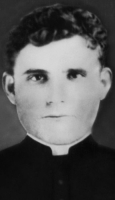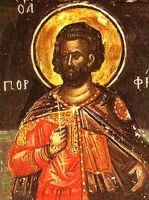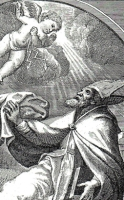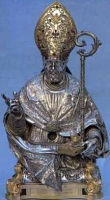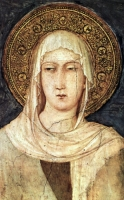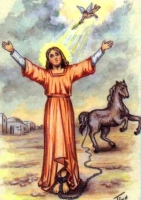Blessed Alojzije Stepinac
Also known as
Aloysius Stepinac
Profile
Raised in the large Catholic Croatian family of Josip and Barbara (nee Penic) Stepinac. Graduated high school on 28 June 1916. Soldier in the Austrian army in World War I, fighting at several points in Italy. Following the collapse of the front in September 1918, he was imprisoned, then released and demobilized in December 1918.
Studied briefly at the Faculty of Agriculture in Zagreb, Croatia, but returned to work at home. He considered marriage, but realized a call to the priesthood, and began his studies in 1924. Studied at the Pontifical Germanicum-Hungaricum College, and earned doctorates in theology and philosophy at the Pontifical Gregorian University, Rome, Italy. Ordained 26 October 1930. Parish priest in the archdiocese of Zagreb. He worked especially in the poor neighbourhoods, and established the archdiocesan Caritas on 23 November 1931.
Named Co-adjutor Archbishop of Zagreb on 29 May 1934 by Pope Pius XI. Created twelve new parishes in the archdiocese, established close ties with lay associations and youth groups, promoted the Catholic press, and helped protect the rights of the Church from the Yugoslavian state. Succeeded Archbishop Bauer on 7 December 1937.
In 1936, the rise of Nazism prompted Stepinac to support a committee helping people fleeing the Reich. Instituted the Action for Assistance to Jewish Refugees in 1938. This period galvanized him a stout defender of human rights regardless of race, religion, nationality, ethnic group or social class, a fight he would continue the rest of his days. During the war, Stepinac helped hide countless people, mainly Jews, in monasteries and other Church property; some remained there throughout the war.
By 1945, Yugoslavia had replaced the oppression of the Nazis with the oppression of the Communists. Stepinac, wrote a biographer, "treated the new authorities…in accordance with the Gospel" but fought for the rights of the Church and the interests of Croatians. After publishing a letter denouncing the execution of priests by communist militants, Stepinac was arrested for the first time.
Following the Archbishop's release, Yugoslavia's new leader, Josip Broz Tito, tried to persuade him to have the Catholic Church in Croatia break from Rome. The Bishops of Yugoslavia issued a pastoral letter on 22 September 1945 in which they referred to the promises made - and broken - by the Belgrade government to respect freedom of conscience, freedom of religion, and private ownership of property. The Bishops demanded freedom for the Catholic press, Catholic schools, religious instruction, Catholic associations, and "full freedom for the human person and his inviolable rights, full respect for Christian marriage and the restitution of all confiscated properties and institutions". The state-run media launched an attack on the Church in general, and the archbishop by name.
Stepinac was tried in September 1946 for defending the unity of the Catholic Church in Croatia, and its unity with Rome. The Pope objected to this show trial, and members of the Jewish community in the United States protested, "…this great man has been accused of being a collaborator of the Nazis. We Jews deny this…. Alojzije Stepinac was one of the few men in Europe who raised his voice against the Nazi tyranny, precisely at the time when it was most dangerous to do so." On 11 October 1946, he was sentenced to 16 years of hard labour and the loss of his civil rights, such as they were.
On 5 December 1951, ill health forced the authorities to move Stepinac from prison to house arrest in Krasic. There he performed priestly functions, received visitors, and wrote more than 5,000 letters, none of which show the slightest resentment for those who persecuted him.
Created cardinal on 12 January 1953 by Pope Pius XII who called him "an example of apostolic zeal and Christian strength. [This is] to reward his extraordinary merits…and especially to honour and comfort our sons and daughters who resolutely confess their Catholic faith despite these difficult times." This apparently was too much for the Yugoslav regime who promptly broke diplomatic relations with Rome. Stepinac, however, retained his position and maintained his stance against the bullying government until his death, which may have been a murder to eliminate an annoyance to that government.
Born
8 May 1898 at Brezaric, Krasic, Croatia as Alojzije Viktor Stepinac
Died
• 10 February 1960 at Krasic, Croatia
• suffered from polycythemia rubra vera, thrombosis of the leg and bronchial catarrh, but may have been poisoned as arsenic was found in his bones during the beatification examination
Beatified
3 October 1998 by Pope John Paul II at Marija Bistrica, Croatia
Saint José Sánchez del Río
Profile
Childhood friend of Father Marcial Maciel who founded the Legionnaires of Christ and who witnessed José's death. At age 13 the boy became a flag-bearer in the Cristero army who were fighting to remain Catholic in the face of anti-religious government decrees; his two older brothers, Macario and Miguel, were soldiers, but no one would let José become a front-line soldier as he wanted. Captured by government troops, he was imprisoned, abused, mutilated, and ordered to renouce Christianity; José refused. Martyr.
Born
28 March 1913 in Sahuayo, Michoacán de Ocampo, Mexico
Died
• hacked with machetes, stabbed with bayonets and finally shot on 10 February 1928 in Sahuayo, Michoacán de Ocampo, Mexico
• interred in the Church of the Sacred Heart of Jesus, Sahuayo
• a bone fragment relic enshrined in the church of the Immaculate Conception, Taft, Texas
Canonized
on 21 January 2016, Pope Francis promulgated a decree of a miracle received through the intercession of Blessed José
Saint Scholastica
புனிதர் ஸ்கொலாஸ்டிகா
கன்னியர் மற்றும் சபை நிறுவனர்:
பிறப்பு: கி.பி. 480
நூர்சியா, ஊம்ப்ரியா, இத்தாலி
இறப்பு: ஃபெப்ரவரி 10, 547
மோண்ட்டே கேசினோ, இத்தாலி
ஏற்கும் சமயம்:
ரோமன் கத்தோலிக்க திருச்சபை
கிழக்கு மரபுவழி திருச்சபை
பாதுகாவல்:
வலிப்பு நோயுள்ள குழந்தைகள் (Convulsive Children), பள்ளிகள், பரிட்சைகள், மழை, இடியிலிருந்து (Invoked Against Storms and Rain), அருட்கன்னியர் (Nuns),
ஃபிரான்ஸ் நாட்டிலுள்ள “லி மன்ஸ்” (Le Mans in France)
புத்தகங்கள், வாசித்தல்
நினைவுத் திருநாள்: ஃபெப்ரவரி 10
புனிதர் ஸ்கொலாஸ்டிகா, ரோமன் கத்தோலிக்க மற்றும் கிழக்கு மரபுவழி திருச்சபைகளின் புனிதராவார். ஒன்பதாம் நூற்றாண்டின் பாரம்பரியத்தின்படி, இவரும் "நூர்சியா நகரின் புனிதர் பெனடிக்ட்டும்" (St. Benedict of Nursia) இரட்டைக் குழந்தைகளாக பிறந்த சகோதரர்கள் ஆவர்.
இத்தாலி நாட்டின் நூர்சியா, ஊம்ப்ரியா (Nursia, Umbria) என்னுமிடத்தில் வசதியான பெற்றோருக்கு 480ம் ஆண்டு பிறந்த ஸ்கொலாஸ்டிகாவின் தந்தையார் பெயர், "ஆன்சியஸ் யூப்ரோபியஸ்" (Anicius Eupropius) ஆகும். தாயார், "கிளாடியா" (Claudia Abondantia Reguardati) ஆவார். ஸ்கொலாஸ்டிகா சிறு வயதிலேயே ஆலயத்தில் கடவுளுக்கு அர்ப்பணிக்கப்பட்டிருந்தார். அவருடைய சகோதரர் பெனடிக்ட் உயர் கல்விக்காக ரோம் புறப்படும்வரை தமையனும் தங்கையும் ஒன்றாகவே வளர்ந்தனர்.
அக்காலத்தில், ஸ்கொலாஸ்டிகாவின் வர்க்கமுள்ள ஒரு ரோம இளம் பெண்ணானவள் தமது தந்தையின் வீட்டில் தனது திருமணம் ஆகும்வரை இருக்கலாம்; அல்லது, அவள் துறவறம் பெற்றுச் செல்லும் வரை இருக்கலாம். ஆனால் வசதி வாய்ப்புள்ள வீட்டுப் பெண்கள் கல்வியறிவு பெற்றவர்களாயும் மரபு வழிப்படி சொத்துரிமை உள்ளவர்களாயும் இருந்தார்கள். சிலபல தருணங்களில் ஒத்தவயது பெண்கள் ஏதேனும் ஒருவரது வீட்டில் கூடி மத சமூகங்களை உருவாக்கினர். அதன்படியே ஸ்கொலாஸ்டிகாவின் வீட்டிலும் சில மத பெண்கள் தங்கியிருந்தனர். ஸ்கொலாஸ்டிகா தமது இளம் வயதிலேயே ஆண்டவருக்கு அர்ப்பணிக்கப்பட்ட பெண்ணாகையால், தந்தையின் மரணம் வரை தமது வீட்டிலேயே இருந்தார். தந்தையின் மரணத்தின் பின்னர், அவரும், அவருடன் இருந்த மத பெண்களும், அருகாமையிலுள்ள பெனடிக்டைன் துறவு மடத்திற்கு சென்றனர்.
ஸ்கொலாஸ்டிகா வருடத்தில் ஒருதடவை தமது தமையனார் பெனடிக்ட் தங்கியிருந்த மடத்தினருகே இருந்த ஒரு இடத்திற்கு சென்று அவரை சந்திப்பது வழக்கம். இருவரும் ஒன்றாக செபிப்பதிலும், வழிபடுவதிலும், புனித நூல்கள் மற்றும் பிரச்சினைகளைப் பற்றி விவாதிப்பதிலும் அந்த நாளை செலவிட்டனர்.
ஒருமுறை, சகோதரர்கள் இருவரும் அதேபோல் பெனடிக்டின் மடத்தினருகே உள்ள ஒரு வீட்டில் சந்தித்து வழிபாட்டிலும் செப காரியங்களிலும் ஈடுபட்டிருந்தனர். அன்றிரவு இரவு உணவின் பின்னர் பெனடிக்ட் தமது மடத்திற்கு புறப்பட தயாரானார். அவரது சகோதரியான ஸ்கொலாஸ்டிகா தமது மரண நாள் நெருங்குவதை உணர்ந்து, பெனடிக்ட் செல்வதை தடுத்தார். மாலைவரை தம்முடன் தங்கியிருந்து ஆராதனை மற்றும் சம்பாஷிப்பதில் ஈடுபட கேட்டுக்கொண்டார். ஆனால் பெனடிக்டோ தாம் செல்வது தவிர்க்க இயலாதது என்றார்.
தமது வேண்டுகோளை தமையன் மறுத்ததும், உடனே கண்களை மூடி, கைகளை இணைத்து கூப்பியபடி செபம் செய்ய ஆரம்பித்தார் ஸ்கொலாஸ்டிகா. அவர் செபிக்கத் தொடங்கியபோது, வானம் தெளிவாக இருந்தது. ஆனால், அவர் செபித்து முடித்ததும், உடனே அவர்கள் தங்கியிருந்த வீட்டின் வெளியே ஒரு காட்டுப் புயல் சுழற்றியடிக்க தொடங்கியது. திடீரென இடி மின்னலுடன், பெருமளவில் மழை பெய்தது, அதுமட்டுமல்ல பெனடிக்ட், அல்லது அவருடன் இருந்த அவரது துறவிகளால், அங்கிருந்து வெளியேற இயலவில்லை.
"ஆண்டவர் உன்னை மன்னிப்பாராக; நீ என்ன செய்துவிட்டாய்? என்று கேட்ட சகோதரனிடம், "இன்றிரவு என்னுடன் தங்குமாறு நான் உன்னை வேண்டினேன், நீ கேட்க மறுத்துவிட்டாய்; நான் என் கடவுளிடம் வேண்டினேன்; செவிமடுத்த அவர், என் விண்ணப்பத்தை ஏற்றுக்கொண்டார்; ஆகவே, உன்னால் இயன்றால் நீ இப்போது என்னை தனியே விட்டுவிட்டு போகலாம்; நீ தாராளமாக உன்னுடைய மடத்திற்கு போ." என்று பதிலளித்தார். பெனடிக்டால் தமது மடத்திற்கு திரும்ப இயலவில்லை. அவர்களிருவரும் அன்று இரவு முழுதும் செபிப்பதிலும், சம்பாஷிப்பதிலும் கழித்தனர்.
மூன்று நாட்களின் பிறகு, தமது சகோதரியின் ஆன்மா, ஒளிரும் வெண்ணிற புறா வடிவில் உயரே பரலோகம் பறந்து செல்வதை பெனடிக்ட் கண்டார். ஸ்கொலாஸ்டிகாவின் உடலை தமது துறவு மடத்திற்கு எடுத்துவந்த பெனடிக்ட், தமக்கென தயாரித்து வைத்திருந்த கல்லறையில் தங்கையின் உடலை அடக்கம் செய்தார்.
ஸ்கொலாஸ்டிகா, பெண்களுக்கான பெனெடிக்டைன் துறவுமட கிளை (Women's Branch of Benedictine Monasticism) ஒன்றின் நிறுவனர் ஆவார்.
Profile
Twin sister of Saint Benedict of Nursia. Born to the Italian noblility. Her mother died in childbirth. Nun. She led a community of women at Plombariola near Montecassino. See the Readings section below for Pope Saint Gregory the Great's telling of some of the stories of her life.
Born
480 in Italy
Died
• 543 of natural causes
• from his cell, Saint Benedict had a vision in which he saw her soul flying to heaven in the form of a dove
Patronage
• against lightning
• against rain
• against storms
• Benedictines
• convulsive children
• nuns
• Le Mans, France
• Monte Cassino Abbey
Representation
• nun with crozier and crucifix
• nun with dove flying from her mouth
• dove
• lily
Blessed William of Maleval
புனித_பெரிய_வில்லியம் (-1157)
இவர் (#StWilliamTheGreat) பிரான்ஸ் நாட்டைச் சார்ந்தவர்.
ஏனோதானோ என்று வாழ்ந்த இவர் ஒருமுறை உரோமைக்குச் சென்று திருத்தந்தை மூன்றாம் யூஜினைச் சந்தித்தார். அவர் இவரிடம் புனித நாடுகளுக்குத் திருபபயணம் மேற்கொள்ளுமாறு சொன்னார். இவரும் அவ்வாறே செய்தார்.
இவர் புனித நாடுகளில் ஓரிரு ஆண்டுகள் இருந்ததும், இவரது வாழ்வில் பெரிய மாற்றம் ஏற்பட்டது. ஆகவே இவர் இத்தாலிக்குத் திரும்பி வந்து, ஒரு துறவியைப் போன்று வாழத் தொடங்கினார். சிறிது காலத்திற்கு இவர் மேல்வால் (MaleVal) என்ற இடத்திற்குச் சென்று ஒரு துறவுமடம் கட்டி வாழ்ந்தார். அங்கு இவரது வாழ்க்கையைப் பார்த்துவிட்டுப் பலரும் இவரது சீடர்களாகச் சேர்ந்தார்கள். அவர்களுக்கெல்லாம் இவர் முன்மாதிரியாக இருந்து, அவர்களை நல்வழியில் வழிநடத்தி வந்தார்.
புனித அகுஸ்தீனின் ஒழுங்குமுறைகளைக் கடைப்பிடித்து வந்த இவரது சபை, பல நாடுகளுக்குப் பரவியது. இவர் 1157 ஆம் ஆண்டு இறையடி சேர்ந்தார்.
இவருக்கு 1202 ஆம் ஆண்டு புனிதர் பட்டம் கொடுக்கப்பட்டது.
Also known as
• William of Guyenne
• William of Malval
• William of Malvalla
• William of Poitiers
• William the Great
• William the Hermit
• Gulielmus, Wilhelmus
Profile
William lived a wild and dissolute life as a soldier in his youth. However, at some point he began to take his religion seriously, left the military life, and made pilgrimages to the Holy Lands. He became superior of an abbey at Pisa, Italy in 1153. He failed in this position, however, and became a hermit on Mount Bruno. He attracted followers, founded a monastery in 1154, and failed again as abbot. William returned to a life as a hermit, this time around Siena, Italy in 1155 in a wilderness called "Maleval" ("evil valley"). There he attracted followers who were called Williamites, Guillemites, or the barefoot friars. They first following William's severe rule, then the Benedictine, and later the Augustinian. They spread through Italy, France, and Germany, but have not survived until today.
Born
French
Died
10 February 1157 of natural causes
Beatified
1202 (cultus confirmed) by Pope Innocent III
Patronage
• Arms manufacturers
• armourers
• blacksmiths
• tinsmiths
• Castiglione della Pescaia, Italy
• Laoag, Philippines, diocese of
• San Fernando La Union, Philippines, diocese of
Representation
• man bearing a cross staff, one arm of which ends in a crescent
• man bearing a shield with four fleur-de-lys
• man wearing a monastic habit over armour
• man with a pilgrim's staff
Blessed Clare Agolanti of Rimini
Also known as
• Chiara Agolanti
• Clara, Klara
Profile
Born to the nobility. Married twice, she spent most of her time in dissolute, sinful pleasures. When her father and brother were executed in civil disturbances, Clare changed her life completely. She became a Franciscan tertiary and founded a convent, though she never became a nun. In an attempt to make up for her earlier life, she practiced penances that were considered extreme even by 14th century standards, and once sold herself into slavery so she could use the money to buy a man out of prison; the local judge commuted the man’s sentence, had the money returned, and Clare was freed.
Legend says that once when some nuns of Rimini were freezing without fuel for their fires, Clare went into the woods, picked up a huge log, and started carrying it to the convent. A relative stopped her and said that it was beneath her dignity as a noble woman to carry wood like a servant. Clare said that if Jesus could carry great pieces of wood to Golgotha for the sake of sinners like her, she could hardly balk at carrying it for the brides of Christ.
Born
1282 at Rimini, Italy
Died
• 10 February 1344 at Rimini, Italy of natural causes
• interred at the convent she founded
Beatified
22 December 1784 by Pope Pius VI (cultus confirmed)
Blessed Alexander of Lugo
Also known as
• Alexander Baldrati
• Alexander Baldrati a Lugo
Profile
Alexander joined the Dominicans in Lugo, Italy in 1612, then studied in Faenza, Naples, and the convent of Our Lady of the Arch. Priest, assigned to Bologna, Italy soon after ordination. He worked himself so hard, in pulpit and with the needy, that he ruined his health and had to be reassigned to Venice, Italy to recover.
As part of his recovery, and to get him away from the over-work that had crushed him, he was sent by sea to the east. The ship stopped on the Greek island of Chios, and Alexander took the opportunity to preach to the locals. An apostate Christian there took the opportunity to stir up sentiment against Alexander, going to the Muslim authorities and swearing that Alexander had converted to Islam. Alexander was dragged to court, interrogated, and offered in rewards if he would bring other Dominicans to Islam. When he denied that he had ever converted to Islam, the court convicted him of being an apostate Muslim, and charged the Christian authorities of harbouring an apostate.
The archbishop and the Dominicans swore that Alexander had always been a Christian. When questioned again, Alexander denounced Islam, Mohammed, and the Koran. After an brief imprisonment, he was martyred by the Muslim authorities and local citizens.
Born
1595 in Lugo, Italy
Died
hacked to pieces and burned at the stake in 1645 on Chios Island, Greece
Saint Austrebertha of Pavilly
Also known as
Austreberta, Eustreberta, Eustreverte
Profile
Daughter of Saint Framechildis and the Count Badefrid. Her parents arranged a marriage for her for political reasons, but Austrebertha was drawn to religious life. Benedictine nun, receiving the veil from Saint Omer at Abbeville, France. Abbess at Jumieges, and at Pavilly. Miracle worker and visionary; at one point in her early life she got a foreshadow of her life - she looked at her reflection in a river and saw a veil over her head.
Born
630 at Therouanne, Artois, France
Died
• 704 at Pavilly, Normandy, France
• relics transferred to Montreuil-sur-Mer, France to keep them safe during the Norman invasion
• relics burned in the French Revolution
Patronage
Barentin, France
Representation
with a wolf (it had killed her donkey so she made it take over the donkey's duties)
Blessed Mikel Beltoja
Profile
Received theological training from Bishop Ernest Çoba of Shkodrë, Albania. Ordained on 8 December 1961 as a priest of the archdiocese of Shkodrë-Pult, Albania. When the Communist government closed all churches in Albania in March 1967, Father Mikel travelled from village to village, ministering to the people, conducting covert Masses where he could. Arrested on 19 April 1973 in Beltoje, Albania, he was imprisoned for several months, tortured and finally given a trial; he used it to speak out against the Communists and their anti–Christian persecutions. Martyr.
Born
9 May 1935 in Beltoj, Shkodrë, Albania
Died
shot by firing squad on 10 February 1974 in Shkodrë, Albania
Beatified
• 5 November 2016 by Pope Francis
• beatification celebrated at the Square of the Cathedral of Shën Shtjefnit, Shkodër, Albania, presided by Cardinal Angelo Amato
Blessed Eusebia Palomino Yenes
Profile
Born to a poor but pious family, when she old enough she had to beg to help them survive. She felt a call to religious life, but worked as a servant in a wealthy household, then a nanny in an orphanage. Religious sister in the Institute of the Daughters of Mary, Help of Christians (Salesian Sisters). She worked as a cook and maid, but her spiritual insights were obvious, and many priests, religious and laity came to her for advice. She had the gift of prophecy, and helped spread devotion to the Wounds of Christ.
Born
15 December 1899 in Cantalpino, Salamanca, Spain
Died
10 February 1935 at Valverde del Camino, Huelva, Spain of natural causes
Beatified
25 April 2004 by Pope John Paul II
Saint Soteris the Martyr
Also known as
Soteris of Rome
Profile
Wealthy 3rd century noble family. A beatiful young woman, she consecrated herself to God. Unlike other women of her day, she dressed plainly with no ornamentation so men would ignore her, and lived a quiet, simple life, forshadowing the female religious orders in years to come. Arrested and tortured in her youth during the persecutions of Decius. Released, she returned to her prayerful life only to be murdered a half-century later in the persecutions of Diocletian for refusing sacrifice to pagan gods. All records indicate that, no matter the torture, she never once cried out. Saint Ambrose of Milan claimed she was one of his ancestor, and he wrote about her.
Died
• beaten and beheaded on 10 February 304 in Rome, Italy
• buried in the Catacombs of San Callisto in Rome
Saint Charalampias
Also known as
Caralampo, Charalambos, Charalampes, Charalampios, Charalampius, Charalampos, Charalampus, Chartalampus, Haralabos, Haralambos, Haralampos, Haralampus, Kharalampos
Profile
Elderly priest in Magnesia, Asia Minor (in modern Turkey). Tortured and martyred with Saint Baptus, Saint Porphyrius of Magnesia, and three unnamed Christian women during the persecutions of Emperor Septimius Severus.
Died
• 203 in Magnesia, Asia Minor (in modern Turkey)
• skull enshrined in the monastery of Saint Stephen in Meteora in central Greece
Patronage
• against plague
• against cattle diseases
• against cholera
Blessed Catherine du Verdier de la Sorinière
Additional Memorial
2 January as one of the Martyrs of Anjou
Profile
Lay woman of the diocese of Angers, France. Martyred in the persecutions of the French Revolution.
Born
29 June 1758 in Saint-Pierre de Chemillé, Maine-et-Loire, France
Died
10 February 1794 in Avrillé, Maine-et-Loire, France
Beatified
19 February 1984 by Pope John Paul II at Rome, Italy
Blessed Marie-Anne Hacher du Bois
Additional Memorial
2 January as one of the Martyrs of Anjou
Profile
Lay woman of the diocese of Angers, France. Martyred in the persecutions of the French Revolution.
Born
3 April 1765 in Jallais, Maine-et-Loire, France
Died
10 February 1794 in Avrillé, Maine-et-Loire, France
Beatified
19 February 1984 by Pope John Paul II at Rome, Italy
Blessed Marie-Louise du Verdier de la Sorinière
Additional Memorial
2 January as one of the Martyrs of Anjou
Profile
Lay woman of the diocese of Angers, France. Martyred in the persecutions of the French Revolution.
Born
27 June 1765 in Saint-Pierre de Chemillé, Maine-et-Loire, France
Died
10 February 1794 in Avrillé, Maine-et-Loire, France
Beatified
19 February 1984 by Pope John Paul II at Rome, Italy
Blessed Hugh of Fosse
Also known as
Hugues
Profile
Priest. Disciple of Saint Norbert, and succeeded him as superior general of the Premonstratensians. Under his leadership the Order grew to 120 houses.
Born
at Fosse, Belgium
Died
• 1164 of natural causes
• relics transferred to the Cathédrale Notre-Dame of Laon, France in 1896
Beatified
13 July 1927 by Pope Pius XI (cultus confirmed)
Blessed Louise Poirier épouse Barré
Additional Memorial
2 January as one of the Martyrs of Anjou
Profile
Married lay woman of the diocese of Angers, France. Martyred in the persecutions of the French Revolution.
Born
22 February 1754 in Le Longeron, Maine-et-Loire, France
Died
10 February 1794 in Avrillé, Maine-et-Loire, France
Beatified
19 February 1984 by Pope John Paul II at Rome, Italy
Saint Trumwin of Whitby
Also known as
• Trumwin of Abercorn
• Trumwine, Trumma, Tumma, Trumwinus, Triumwini, Trumuini
Profile
Bishop of the Southern Picts in Scotland in 681; he worked from the monastery of Abercorn on the Firth of Forth. When King Egfrid was killed by the Picts in 685, Trumwin and his monks had to flee the area. Retired to spend his later years as a prayerful monk in Whitby, England.
Died
c.704 of natural causes
Blessed Paul of Wallachia
Profile
Studied law at the University of Bologna, Italy. A friend of Saint Dominic de Guzman, Paul joined the Dominicans and returned to Hungary to establish the Order there. With a group of approximately 90 others, he travelled to Wallachia, an area of modern Romania, as a missionary to the pagan Cumans. They were all martyred.
Born
Hungary
Died
c.1240 in Wallachia (in modern Romania)
Blessed Pierre Frémond
Addtional Memorial
2 January as one of the Martyrs of Anjou
Profile
Layman of the diocese of Angers, France. Martyred in the persecutions of the French Revolution.
Born
16 September 1754 in Chaudefonds, Maine-et-Loire, France
Died
10 February 1794 in Avrillé, Maine-et-Loire, France
Beatified
19 February 1984 by Pope John Paul II at Rome, Italy
Saint Baptus of Magnesia
Also known as
Bapto, Baptos, Dauktos, Dauto
Profile
Eyewitness to executions of Christians who was so moved by their courage that he examined the faith and converted. Martyred with five companions during the persecutions of Emperor Septimius Severus.
Died
203 in Magnesia, Asia Minor
Blessed Louise Bessay de la Voûte
Profile
Lay woman of the diocese of Angers, France. Martyred in the persecutions of the French Revolution.
Born
22 August 1721 in Saint-Mars-des-Prés, Vendée France
Died
10 February 1794 in Avrillé, Maine-et-Loire, France
Beatified
19 February 1984 by Pope John Paul II at Rome, Italy
Saint Porfirio
Also known as
Porfyrius, Porphyrius, Porphyry
Profile
Imperial executioner who was so moved by the courage of the Christians he was murdering that he examined the faith and converted. Martyred with five companions during the persecutions of Emperor Septimius Severus.
Died
203 in Magnesia, Asia Minor
Blessed Eusebius of Murano
Profile
Born to the Spanish nobility, he became ambassador from the Spanish throne to the Republic of Venice (in modern Italy). Leaving the worldly life, he became a Camaldolese monk at the San Michele monastery on the islands of Murano, Italy.
Born
15th century Spain
Died
1501 of natural causes
Blessed Bruno of Minden
Also known as
• Bruno of Waldeck
• Brun...
Profile
Bishop of Minden, Germany on 5 May 1037, serving for 18 years. Founded the monastery of Saint Mauritius on Werder island near Minden.
Died
10 February 1055 of natural causes
Saint Prothadius of Besançon
Also known as
Protadius, Protagius
Profile
Bishop of Besançon, France in the early 7th century.
Died
624
Saint Erluph of Werden
Also known as
Erlulph
Profile
Missionary to Germany. Bishop of Werden, Germany. Martyred by pagans.
Born
Scotland
Died
830
Saint Aponius of Bethlehem
Profile
First century convert martyred in the persecutions of King Herod Antipas.
Died
1st century Bethlehem
Saint Troiano of Saintes
Also known as
Trojan
Profile
Fifth-century bishop of Saintes, Aquitaine (in modern France).
Died
c.500
Saint Andrew of Bethlehem
Profile
First century convert martyred in the persecutions of King Herod Antipas.
Died
1st century Bethlehem
Saint Cronan of Clashmore
Profile
Martyred by pagan Danes.
Died
631 near Dublin, Ireland
Patronage
Clashmore, Ireland
Saint Derlugha of Lemmagh
Also known as
• Derlugha of Lawyn
• Darluga...
Profile
Nun.
Saint Silvanus of Terracina
Profile
Fourth-century bishop of Terracina, Italy.
Blessed Paganus
Profile
Benedictine monk in Sicily. Hermit.
Born
Italian
Died
1423
Saint Salvius of Albelda
Profile
Abbot at Albelda, Spain.
Died
962
Saint Baldegundis
Profile
Abbess of Saint-Croix in Poitiers, France.
Died
c.580
Martyred Soldiers of Rome
Profile
A group of ten Christian soldiers who were martyred together for their faith. We know little more about them but four of their names - Amantius, Hyacinth, Irenaeus and Zoticus.
Died
• 120 at Rome, Italy
• buried on the Via Lavicana outside Rome
Also celebrated but no entry yet
• Our Lady of the Dove
• Saint Paul Shipwrecked
• William X of Aquitaine







